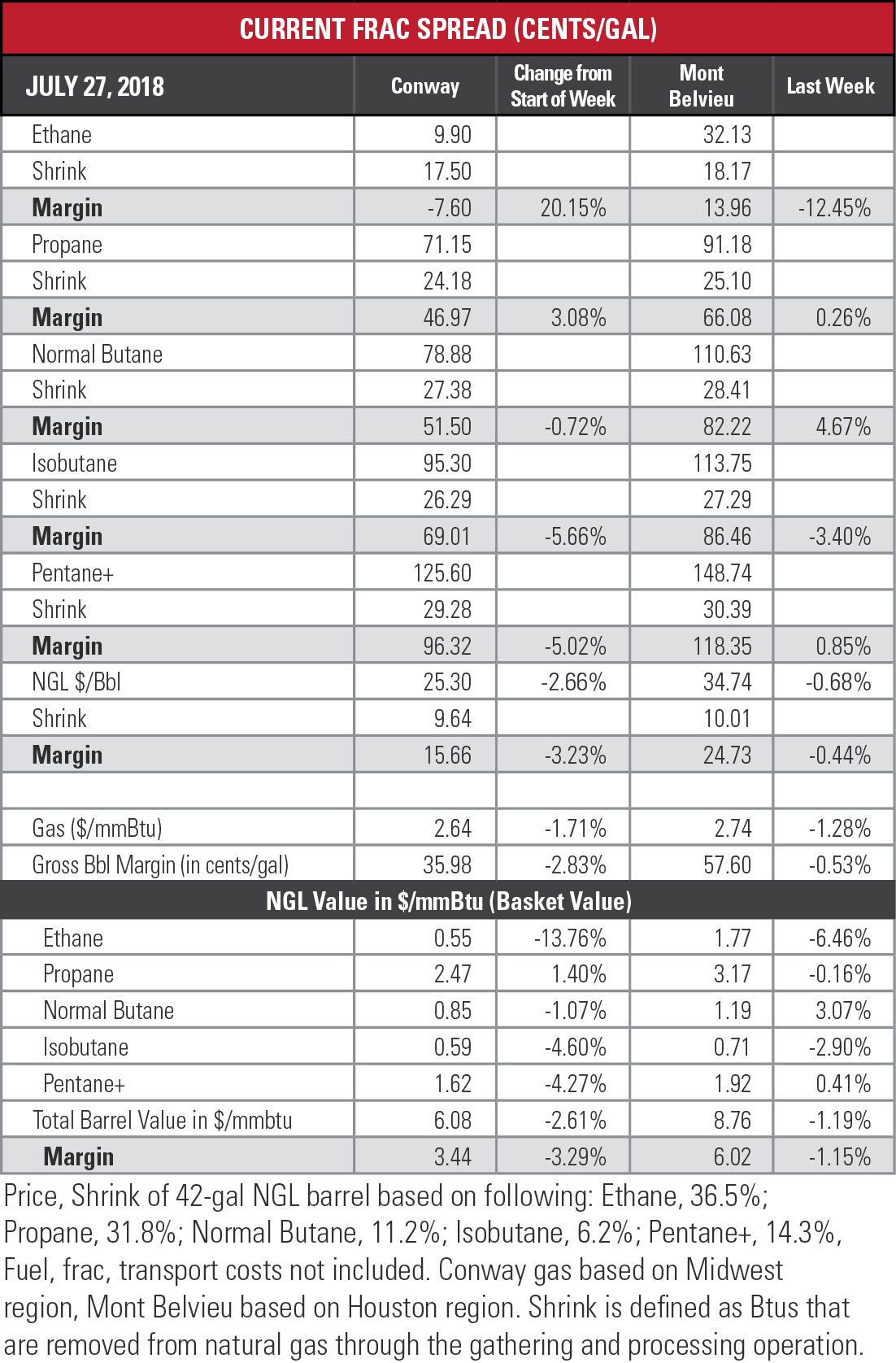
The price of natural gas eased up in the past week as cooler-than-expected temperatures lowered power generation and gas demand.
Those walking their dogs on Texas evenings with a heat index of 106 degrees might be skeptical of the previous sentence, but fake news it is not. A wide swath of below-average or slightly below-average temps is sweeping on a southwest trend from North Dakota through the plains toward Florida. On the East Coast, heavy rains are causing flash floods from the Carolinas to New England.
 Extreme heat from California to Texas counters that potential market but that region is also home to significant renewable power generation. But here’s the thing, as noted by Envantage Inc.: wind generation tends to be reduced during peak electricity demand times in the summer.
Extreme heat from California to Texas counters that potential market but that region is also home to significant renewable power generation. But here’s the thing, as noted by Envantage Inc.: wind generation tends to be reduced during peak electricity demand times in the summer.
Dog walkers hoping for a breeze to offer relief figured that one out on their own.
Even solar power generation is less effective, says Envantage. The higher temperatures actually reduce output from the photovoltaic panels, leading to higher-than-normal natural gas-fired generation.
Ethane’s price fell at Mont Belvieu, Texas, and Conway, Kan., last week and margins shrunk at both hubs, as well. The Mont Belvieu price is down 12.3% in the last two weeks following a 48% rise from mid-May, what Envantage considers a needed market correction.
 Exxon Mobil Corp. (NYSE: XOM) announced July 26 that its Baytown, Texas, ethane cracker was fully operational. The 1.5 million-metric-ton facility will be a market mover, along with Indorama Corp.’s overhauled cracker in Lake Charles, La., expected to restart in August.
Exxon Mobil Corp. (NYSE: XOM) announced July 26 that its Baytown, Texas, ethane cracker was fully operational. The 1.5 million-metric-ton facility will be a market mover, along with Indorama Corp.’s overhauled cracker in Lake Charles, La., expected to restart in August.
Envantage estimates ethane inventory at 28 days, but the increased demand from a major plant like Exxon Mobil’s could easily pull that level down to 24 days.
“History has shown that when ethane inventory days-of-supply go below 25 days that ethane prices can show dramatic increases from time to time as bottlenecks become more prominent,” said Envantage. Those bottlenecks could include inadequate takeaway and fractionation capacity for ethane, or brine limitations at Mont Belvieu.
Propane has experienced a 5.6% dip at Mont Belvieu in the last two weeks but Envantage is not concerned. Its analysts dismiss concerns of a propane surplus, noting that even as propane extraction has increased this year, so have exports.
“Each time that Mont Belvieu prices cycle down, propane export spreads improve, allowing for U.S. propane exports to remain strong,” Envantage said. The analysts maintain that the combination of crude oil prices and propane exports will maintain a price no lower than the mid-80 cents per gallon and expect the price to increase in the next few weeks.
 In the week ended July 20, storage of natural gas in the Lower 48 experienced an increase of 24 billion cubic feet, the U.S. Energy Information Administration reported. The figure resulted in a total of 2.273 trillion cubic feet (Tcf). That is 23.7% below the 2.978 Tcf figure at the same time in 2017 and 19.7% below the five-year average of 2.83 Tcf.
In the week ended July 20, storage of natural gas in the Lower 48 experienced an increase of 24 billion cubic feet, the U.S. Energy Information Administration reported. The figure resulted in a total of 2.273 trillion cubic feet (Tcf). That is 23.7% below the 2.978 Tcf figure at the same time in 2017 and 19.7% below the five-year average of 2.83 Tcf.
Joseph Markman can be reached at jmarkman@hartenergy.com or @JHMarkman.
Recommended Reading
US Drillers Cut Oil, Gas Rigs for First Time in Six Weeks
2025-01-10 - The oil and gas rig count fell by five to 584 in the week to Jan. 10, the lowest since November.
On The Market This Week (Jan. 6, 2025)
2025-01-10 - Here is a roundup of listings marketed by select E&Ps during the week of Jan. 6.
Perma-Pipe Gets $43MM Contract for Services in Middle East
2025-01-10 - Texas company Perma-Pipe International Holdings specializes in anti-corrosion services for infrastructure.
Shale Outlook: E&Ps Making More U-Turn Laterals, Problem-Free
2025-01-09 - Of the more than 70 horseshoe wells drilled to date, half came in the first nine months of 2024 as operators found 2-mile, single-section laterals more economic than a pair of 1-mile straight holes.
Murphy’s Vietnam Find May Change Investor Views, KeyBanc Analysts Say
2025-01-09 - The discovery by a subsidiary of Murphy Oil Corp. is a reminder of the company’s exploration prowess, KeyBanc Capital Markets analysts said.
Comments
Add new comment
This conversation is moderated according to Hart Energy community rules. Please read the rules before joining the discussion. If you’re experiencing any technical problems, please contact our customer care team.





